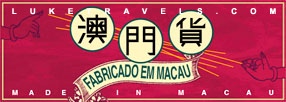|
|
Macau Travel Guide > Best of Macau
Largo de Senado
An hour's people-watching in the lively Largo do Senado (Senate Square) makes a great
introduction to Macau. While you're here, check out the stunning tiled courtyard of the
Leal Senado building, off the southern side of the square.
The town of Macau started down in the south of the peninsula, around the bay-front
road known as the Praia Grande, and grew out from there. Unfortunately, these days a
stroll on the seafront is not what it was, with the bay now being enclosed and reclamation
work underway. More rewarding is the main road that cuts the Praia from east to west,
called Avenida do Infante d'Henrique to the east and Avenida de Almeida Ribeiro to the
west. At the eastern end of the road rises the extraordinarily garish Lisboa Hotel, though
most of the interest lies in the section west of the Praia, particularly in the beautiful
Largo do Senado (Senate Square) which marks the downtown area and bears the unmistakable
influence of southern Europe, not only in its architecture, but also in its role as a
place for people to stroll, sit and chat in open air.
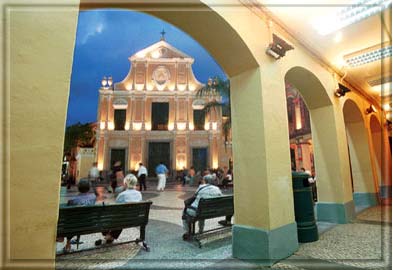
© Macau Government Tourist Office
At the northern end of Largo do Senado, away
from the main road, is the beautiful seventeenth-century Baroque church, São Domingos,
while to the south, facing the square from across the main road, stands the Leal Senado
(Mon-Sat 1-7pm; free), generally considered the finest Portuguese building in the city. If
you step into the interior courtyard here you'll see wonderful blue and white Portuguese
tiles around the walls, while up the staircase from the courtyard, you reach first a
formal garden and then the richly decorated senate chamber itself. In the late sixteenth
century this hall used to be packed out with the entire citizenry of the colony, who
gathered to debate issues of importance. The senate's title leal (loyal) was earned during
the period when Spain occupied the Portuguese throne and Macau became the final stronghold
of loyalists to the true king. Today the senate chamber is still used by the municipal
government of Macau, though it's hardly the democratic chamber of old. Adjacent to the
chamber is the wood-carved public library, whose collection includes a repository of many
fifteenth- and sixteenth-century books which you can still see on the shelves.
 
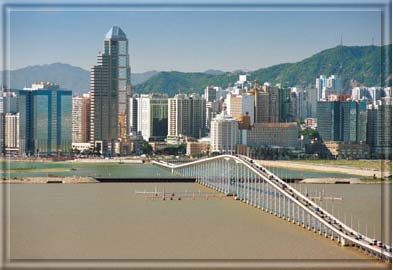
Copyright Macau Government Tourist Office
A couple of hundred metres west from Largo do Senado, Almeida Ribeiro emerges on to the
so-called Inner Harbour, which overlooks, and is sheltered by, the mainland just across
the water. Ferries to Guangzhou still use this harbour, though its main interest for many
visitors is the Floating Casino, an ugly wooden contraption on the water, teeming with
gamblers at all hours. Some of the streets immediately inland from here, especially those
just north of Almeida Ribeiro, are worth poking around. Streets such as Rua Felicidade,
parallel with Almeida Ribeiro, have shaken off their former seediness and are now full of
friendly restaurants and small hotels. South from the Floating Casino, the seafront road,
Rua das Lorchas, is lined by old arcades and characterful shops.
São Paulo
The church of São Paulo is Macau's most famous landmark, and its ornately-carved facade,
rich with Catholic statuary, is an imposing sight. A few hundred meters north of Largo do Senado is Macau's most famous landmark, the
church of São Paulo, once hailed as the greatest Christian monument in east Asia, but
today surviving as no more than a facade. Originally constructed at the beginning of the
seventeenth century, it dominated the city for two hundred years until its untimely
destruction by fire in 1835. Fortuitously, however, the facade, which did not collapse,
was always considered the highlight of the building - richly carved and laden with
statuary, the cracked stone still presents an imposing sight from the bottom of the stone
steps leading up from the Rua de São Paulo.
Immediately east of São Paulo looms another early seventeenth-century monument, the
Fortaleza do Monte (daily 9am-5.30pm; free). Climb up and take a stroll round the old
ramparts for some great views over the city. It's an impressive pile, though it was only
once used in a military function, to repel the Dutch in 1622, when it succeeded in blowing
up the Dutch magazine with a lucky shot from a cannon ball.
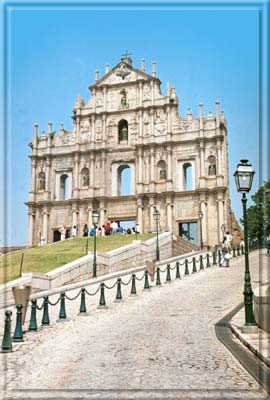
© Macau Government Tourist Office
Negotiating the roads a few hundred metres
northwest of São Paulo brings you to perhaps the nicest part of Macau, around Praça
Luís de Camões (also accessible on buses #19 and #23 from Almeida Ribeiro). North,
facing the square, is the Jardim Luís de Camões, a delightful shady park full of large
trees and popular with locals. The park was built in honour of the great sixteenth-century
Portuguese poet, Luís de Camões, who is thought to have been banished here for part of
his life. Immediately east of the square, though, is the real gem, the Old Protestant
Cemetery, where all the non-Catholic traders, visitors, sailors and adventurers who
happened to die in Macau were buried. The gravestones have all been restored and are quite
legible. In this quiet garden, under the shade of trees, the last testaments to these
mainly British, American and German individuals, who died far from home in the early part
of the last century, make incredibly poignant reading.
Guia Fortress
Take a leisurely hour-long hike up to the Guia Fortress for unbeatable panoramic views of
the whole peninsula. On a clear day, you can even make out faraway Lantau Island. About 1km northeast of the Fortaleza do Monte, is another area worth walking around
(buses #12 and #22 run up here from the Hotel Lisboa along the Avenida do Conselheiro
Ferreira de Almeida). At the junction with Estrada de Adolfo Loureiro, the first site
you'll reach, screened off behind a high wall, is the scenic Jardim Lou Lim Ioc (daily
6am-10pm; 1ptca), a formal, Chinese garden full of bamboos, pavilions, birds in cages and
old men playing mah jong. A couple of minutes around the corner from here you'll find the
Sun Yatsen Memorial Home (Mon & Wed-Fri 10am-1pm, Sat & Sun 3-5pm; free) at the
junction of Avenida de Sidonia Pais and the Rua de Silva Mendes. There isn't that much to
see - basically it's an attractive, rambling old mansion scattered about with mementoes of
Sun Yatsen, who spent some time living in Macau in the years before he turned to
revolutionary activities. Drop by to see the turn-of-the-century interior decor if nothing
else.
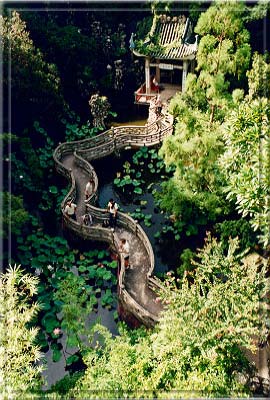
© Macau Government Tourist Office
The sharp hill to the east of here is Macau's
highest, and its summit is crowned by the seventeenth-century Guia Fortress, the dominant
feature of which is a charming whitewashed lighthouse, added in the last century and
reputed to be the oldest anywhere on the Chinese coast. You can take a leisurely hike
along a path up to the fort in about an hour for some superb views over the whole
peninsula, including, on a clear day, a glimpse of Lantau Island far to the east. There's
a tourist information centre and café (daily 9am-5.30pm) up here as well.
Gambling
Macau has been famous for its casinos since it legalized gambling in the 1850s. Hotel
Lisboa's four-storey casino is the largest on the peninsula, and makes a
fascinating visit. The eight official Macau casinos, although numerous and always packed, have none of
the glamour of casinos in places such as Las Vegas or Monte Carlo. You are free to enter
any casino at any time of the day or night, dressed in any attire, with the only
restriction being that you should be eighteen years of age, and your cameras should be
deposited at the entrance. Once inside, another restriction you should note is that there
is a minimum bet of 50ptca on nearly all games.

© Macau Government Tourist Office
The four-storey casino in the Hotel Lisboa is
the largest and probably the most interesting for a visit. For information on how to play
the various games, ask the Macau Tourist Information Bureau (MTIB) for a leaflet, or buy
their more detailed A-O-A Macau Gambling Guide. Be warned, however: signs in tiny print at
the entrances to the casinos politely suggest that punters should engage in betting for
fun only, and not as a means of making money. Revenues from the gambling trade in Macau
are thought to approach half a billion US dollars annually.
Dinner at Hotel Bela Vista
With its superb views and old-world elegance, Bela Vista Hotel's verandah is
Macau's finest venue for dinner.
Alfonso III, Rua Central 11. Genuine and excellent Portuguese food in a Portuguese
environment, though the waiters speak English. Centrally located, not far from Largo do
Senado.
Ali's Curry House, Avenida da República 4. Interesting Indian food, served in a quiet
seafront area with outdoor tables below the Bela Vista hotel, a ten-minute walk south from
the Praia Grande.
Bela Vista Hotel, Rua Comendador Kou Ho Neng (965 333). It's hard to imagine a finer place
for dinner than the verandah of this classic colonial-style hotel. Excellent Portuguese
food is served and the prices are not as high as you would expect - 300ptca per head
maximum. Advance booking essential.
Café Sang Lei, on a small alley, parallel with Rua do Pedro Jose Lobo, in the area
between the northern section of Praia Grande and Avenida do Infante Henrique. One of a
couple of cafés here with lots of outdoor tables where you can get coffee, beers and
snacks during the day.
La Casa Macanese, Rua de São Lourenço. A couple of hundred metres south up the hill from
Almeida Ribeiro (follow the continuation of Rua Central). Interesting Macanese dishes
including African chicken in an unpretentious environment.
Fat Siu Lou, Rua da Felicidade 64. A very popular, traditional old restaurant in an area
busy with cafés and restaurants.
Leitoria I Son, Largo do Senado 7. Virtually next door to Long Kei, this is an excellent
milk bar offering milk with everything - fruit, chocolate, eggs, ice creams, puddings and
breakfasts.
Long Kei, Largo do Senado 7B. A one-hundred-year-old traditional but inexpensive Cantonese
restaurant, on the left side as you face the square from Almeida Ribeiro. Dim sum
available.
Pele Restaurant, Rua de São Tiago da Barra 25. A short walk south of the Maritime Museum
and offering excellent Macanese dishes in a friendly atmosphere.
Restaurante Safari, Patio do Coto Velo 14. Very close to the Leal Senado, this restaurant
offers excellent cheap meals, ranging from European breakfasts to spicy steaks and fried
noodles.
Taipa's Avenida de Praia
Take a stroll along the Avenida de Praia, Taipa Island's romantic colonial
promenade whose faded mansions and old wooden benches seem frozen in time. Until the eighteenth century Taipa used to be two islands separated by a channel,
the silting up of which subsequently caused the two to merge into one. In an interesting
repetition of history, the same fate is now befalling Taipa and Coloane, except that this
time it is not siltation which is the culprit, but land reclamation - the two islands are
being deliberately fused into one, to make space for new development.
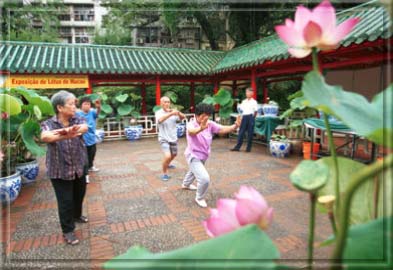
© Macau Government Tourist Office
Although Taipa's northern shore is hardly worth
a stop now that it is being subsumed into the general Macau conurbation, Taipa Village on
the southern shore, with its old colonial promenade, makes a pleasant stop for an extended
lunch. There isn't much more than a few streets to the modern village, where the buses
stop, though there are some great restaurants along the central north-south alley Rua do
Cunha, and, to the west - the right as you face the shore - a couple of temples in the
vicinity of a quiet old square. Next to the Pak Tai Temple there's also a bike rental
outlet where you can rent bikes for 12ptca an hour, if you want to continue your
exploration of Coloane under your own steam.
The real interest lies a few minutes' walk to the east of Taipa Village, at the old
waterfront area. Here, as though frozen in time, remains a superb old colonial promenade,
the Avenida da Praia, complete with its original houses, public benches and street lamps.
Great, faded mansions with verandahs overlook the water which has now receded almost out
of sight and been replaced by thick shrubbery. One of the mansions, the Taipa House Museum
(Tues-Sun 9.30am-1pm & 3-5.30pm; free) is open to the public and reveals details of
turn-of-the-century domestic life for the resident bourgeoisie. The residents of these
houses were Macanese families, highly religious, well-to-do but not enormously wealthy.
Unsurprisingly, the furniture is a Eurasian hybrid, combining features such as saint
statuettes with Chinese dragon motifs on the sofas.
Hac Sa Beach
Hac Sa Beach, on Coloane island, is the best beach in Macau, and dinner at
Fernando's - with its live guitar music and great Portuguese food - adds the
perfect finishing touch to an afternoon on the sands. Coloane is considerably bigger than Taipa and, although it has no outstanding
attractions, it's a pleasant place to spend a few hours. The buses all stop at the
roundabout in Coloane Village on the western shore, overlooking mainland China just across
the water. There's no beach, just mud, in which you'll see old men fishing with nets. To
the north of the village are a few junk-building sheds, while the street leading south
from the village roundabout, one block back from the shore, contains a couple of
interesting old shops and the unexpected yellow and white St Xavier Chapel where a relic
of the saint's arm bone is venerated. A couple of hundred meters beyond this is the Tam
Kong Temple, housing a metre-long whale bone carved into the shape of a ship.
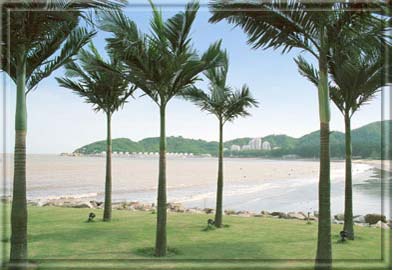
© Macau Government Tourist Office
On the north side of the village roundabout
there's a small shop where you can rent bicycles for 12ptca an hour. Cycling is a good way
to travel the 3km farther round to Hac Sa Beach on the eastern shore (otherwise take bus
#14, #26 or #26A), perhaps dropping in on Cheoc Van Beach to the south on the way as well.
The beach at Hac Sa, though, tree-lined and stretching far off round the bay, is without
doubt the best in Macau, despite the black colour of its sand, and has good facilities
including showers and toilets as well as some fine nearby restaurants. There's also a
sports and swimming pool complex here (daily 9am-9pm).
Pousada de Sao Tiago
The incredible Pousada de Sao Tiago is built into the ruins of an old
fortress. Its entrance corridor is a stone tunnel dripping with water -
follow it up to the veranda for great ocean views. The small but hilly tongue of land south of Almeida Ribeiro is a highly interesting
place to stroll, with colonial mansions and their gardens looming up round every corner.
The best way to start exploring this area is to walk up the steep Rua Central leading
south from Almeida Ribeiro just east of Largo do Senado. After five minutes you can detour
off on a small road to your right, which contains the pastel-coloured early
nineteenth-century church of Santo Agostinho. Back along Rua Central again will lead you
to another attractive church of the same era, the cream and white São Lourenço, standing
amid palm trees.
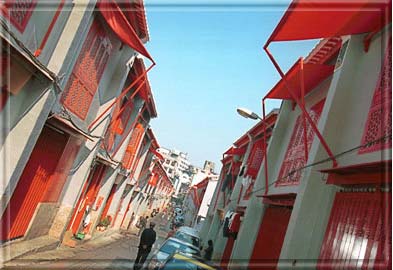
© Macau Government Tourist Office
Continuing several hundred metres farther south
you'll reach the seafront on the southwestern side of the peninsula. As you face the sea,
the celebrated A Ma Temple is immediately to your right. Situated underneath Barra Hill
overlooking the Inner Harbour, this temple may be as old as six hundred years in parts,
and certainly predates the arrival of the Portuguese on the peninsula. Dedicated to the
goddess A Ma, whose identity blurs from Queen of Heaven into Goddess of the Sea (and who
seems to be the same as Tin Hau in Hong Kong), the temple is an attractive jumble of
altars and little outhouses among the rocks.
Immediately across the road from here, on the seafront, stands the twentieth century's
votive offering to the sea, the Maritime Museum (daily except Tues 10am-5pm; 8ptca, Sun
4ptca). This is an excellently presented, modern museum, covering old explorers, seafaring
techniques, equipment, models and boats. For an additional charge, you can even join a
boat tour (daily 10.30am, 11.30am, 3.30pm & 4.40pm; 15ptca) on one of the junks moored
just outside the museum. This gives you a chance to sail around the Inner Harbour, hearing
details of the lives of local fishermen in English.
A short walk south along the shore from the museum brings you to the very tip of the
peninsula, which is today marked by the Pousada de São Tiago, an incredible hotel built
into the remains of the seventeenth-century Portuguese fortress, the Fortaleza de Barra.
Enter the front door and you find yourself walking up a stone tunnel running with water -
it's well worth climbing up to the Pousada's verandah café for a drink overlooking the
sea. Continuing the walk around the southern headland, and back to the north again, you'll
pass another superb hotel high up on your left, the gleaming white Bela Vista, the finest
colonial-style hotel in the territory and a beautiful throwback to another age. The road
north from here up to the Praia Grande, near the Hotel Lisboa, takes about another ten
minutes on foot. The wonderful pink building on your left shortly before the Praia Grande
is the nineteenth-century Palácio do Governo, which unfortunately is not open to
visitors.
  
Home Page | Travel Guide |
Photos
| Contact Us |
LukeTravels.com Main Page |
Advertise Here |
Explore Japan | Explore Hong
Kong | Explore Thailand |
Explore The Philippines
|

